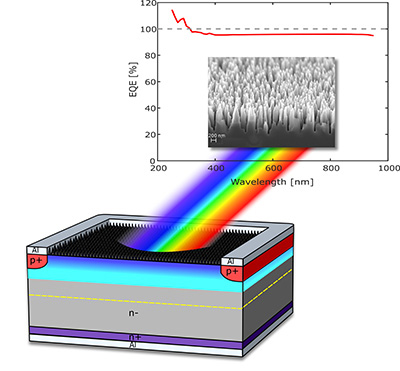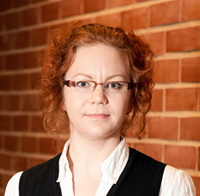Light Detector Records Photons from UV Through IR
Researchers at Aalto University reach near-unity response; with applications in medicine and safety.
Wide ranging: the structure and performance of the novel photodetector.
A potentially market-disruptive light detector, developed by a team led by Professor Hele Savin at Finland’s University of Aalto, captures more than 96 percent of available photons, across the entire range of visible, ultraviolet and infrared wavelengths.
“Present-day light detectors suffer from severe reflection losses as the currently used antireflection coatings are limited to specific wavelengths and a fixed angle of incidence,” said Prof. Savin. “Our detector captures light without such limitations by taking advantage of a nanostructured surface. Low incident angle is useful especially in scintillating X-ray sensors.”
No doping required
The new detector does not require the addition any dopants to collect the wide range of light frequencies; instead it uses an inversion layer, which is generated by atomic layer deposited thin film. The team’s work is described in the latest edition ofNature Photonics.
Prof Savin said, “We have also addressed electrical losses occurring in traditional sensors that utilize semiconductor pn-junctions for light collection. Our detector does not need any dopants to collect light; instead we use an inversion layer generated by atomic layer deposited thin film.”
The new concept for light detection was developed from the team’s earlier research on nanostructured solar cells. Indeed, the nanostructure used in the new light detector is similar to that used by the team a couple of years ago in their record-high efficiency black silicon solar cells.
The team filed a patent application for the new light detector. Prototype detectors are currently being tested in imaging applications related to medicine and safety. The team is seeking new applications for the invention, especially among the ultraviolet and infrared ranges that would benefit from the superior spectral response.
(From: http://optics.org/news/7/11/25)


